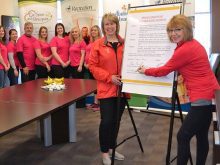Tuesday’s Ontario budget commits the province’s ag ministry to extend its risk management program (RMP) past its pilot stage, and to broaden its coverage beyond grains and oilseeds to include cattle, hogs, sheep and veal.
Lobbying efforts to make the RMP permanent, with or without federal co-funding, have been a priority in recent weeks for most of Ontario’s farm groups, many of which made their approval known Tuesday.
“Today’s announcement is great news for Ontario farmers, rural communities and everyone involved in agriculture and agri-food,” Simcoe County cattle producer Curtis Royal, president of the Ontario Cattlemen’s Association, said in a release.
Read Also

China seeks improved ties with Canada amid rising trade tensions
China called on Friday for steps to improve bilateral ties with Canada, saying there were no deep-seated conflicts of interest, following a spike in trade tensions with many of Beijing’s Western trade partners this year.
“The fact that the McGuinty government decided to act during these tough fiscal times, and without the participation of the federal government, makes this announcement that much more significant to Ontario farmers,” Bruce County producer and Ontario Pork chair Wilma Jeffray said in the same release.
“The government recognizes that volatility in commodity markets can make it difficult for farmers to manage business risks,” the provincial finance ministry said in Tuesday’s budget documents. “Risk management programs can help mitigate these difficulties by providing stable support for managing costs.”
The budget specifically commits the province to extend the current pilot RMP for grain and oilseed farmers, implement a new RMP for the cattle, hog, sheep and veal sectors, and set up a “self-directed” RMP for Ontario’s edible horticulture sector.
The RMPs’ approach “would provide bankability, stability and predictability while responding to market trends over the long term,” the province said.
“Scaled back”
The cost of these programs is to be shared, for now, between the province and farmers, the budget noted. Producers will pay 30 per cent of the program’s overall cost.
“The federal government refused to participate in the previous RMP pilot, but Ontario challenges it to pay its traditional 60 per cent share to help farmers in the province grow forward,” the province said.
“In the absence of federal government participation, it is envisioned both the premiums and the program benefits would be scaled back accordingly,” Ontario Pork and the OCA said in their joint release Tuesday.
The RMP, launched for crop producers in a three-year pilot form in 2007 and temporarily extended last summer to cover the 2010 crop year, has been administered by Agricorp.
During the pilot, participants would see RMP payments triggered when prices for eligible grains and oilseeds fell below a specific support level, based on a cost-of-production formula. Three coverage levels were available for each crop in 2010: 95, 90, or 85 per cent of the cost of production.
“Most hope”
“The leadership shown today by the McGuinty government sets a new standard in the province and ensures the sustainability of our family farms,” Don Kenny, chair of Grain Farmers of Ontario, said Tuesday in a separate release.
Other members of the Ontario Agriculture Sustainability Coalition (OASC) of ag groups also hailed the announcement. RMP “will be a critical tool to give our farmers the predictability, stability and bankability they need to move their businesses forward,” said Bette Jean Crews, president of the Ontario Federation of Agriculture.
“RMP was by far the best solution that offered farmers the support they have been requesting and the most hope for their future,” said Henry Stevens, president of the Christian Farmers Federation of Ontario.
Among other ag-related budget items, the province pledged $20 million for the Friends of the Greenbelt Foundation to allow it to “leverage further investments and continue to promote agriculture, tourism and environmental integrity in Ontario’s Greenbelt.”
The Greenbelt is the designated zone of permanent protection for about 1.8 million acres of farmland and other “environmentally sensitive” land around southern Ontario’s Greater Golden Horseshoe.














